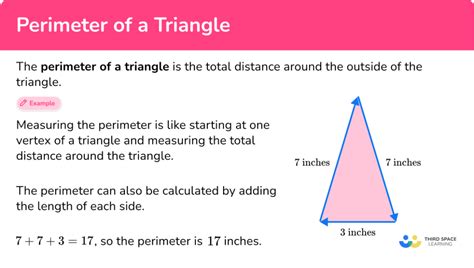How to Calculate the Perimeter of a Triangle: A Simple Guide
Understanding how to calculate the perimeter of a triangle is a fundamental concept in geometry. This guide will walk you through the process, providing clear explanations and examples to help you master this essential skill. Whether you're a student tackling geometry homework or simply brushing up on your math knowledge, this guide is for you.
What is the Perimeter of a Triangle?
The perimeter of any polygon, including a triangle, is simply the total distance around its outer edges. In other words, it's the sum of the lengths of all its sides. For a triangle, this means adding together the lengths of its three sides.
Formula for Calculating the Perimeter of a Triangle
The formula for calculating the perimeter (P) of a triangle is incredibly straightforward:
P = a + b + c
Where:
- a, b, and c represent the lengths of the three sides of the triangle.
Step-by-Step Guide to Calculating the Perimeter
-
Identify the side lengths: First, you need to know the lengths of each of the three sides of your triangle. These lengths are usually given in a problem or can be measured directly if you have a physical triangle.
-
Add the side lengths: Once you have the lengths of all three sides (a, b, and c), add them together. This sum represents the perimeter of the triangle.
-
Units: Remember to include the appropriate units (e.g., centimeters, meters, inches, feet) in your final answer. The units of the perimeter will be the same as the units used for the side lengths.
Examples
Let's work through a couple of examples to solidify your understanding:
Example 1:
A triangle has sides with lengths of 5 cm, 7 cm, and 10 cm. Calculate the perimeter.
Solution:
P = 5 cm + 7 cm + 10 cm = 22 cm
The perimeter of the triangle is 22 cm.
Example 2:
A triangle has sides with lengths of 3 inches, 4 inches, and 5 inches. Calculate the perimeter.
Solution:
P = 3 inches + 4 inches + 5 inches = 12 inches
The perimeter of the triangle is 12 inches.
Different Types of Triangles
The method for calculating the perimeter remains the same regardless of the type of triangle (equilateral, isosceles, scalene). The only difference lies in the relationship between the side lengths:
- Equilateral Triangle: All three sides are equal in length.
- Isosceles Triangle: Two sides are equal in length.
- Scalene Triangle: All three sides are of different lengths.
Troubleshooting Common Mistakes
- Units: Ensure that all side lengths are measured using the same unit before adding them.
- Addition Errors: Double-check your addition to avoid simple calculation errors.
- Missing Information: Make sure you have the lengths of all three sides before attempting to calculate the perimeter.
Mastering the calculation of a triangle's perimeter is a crucial step in understanding more complex geometric concepts. By following these steps and practicing with different examples, you'll quickly become proficient in this essential skill.
